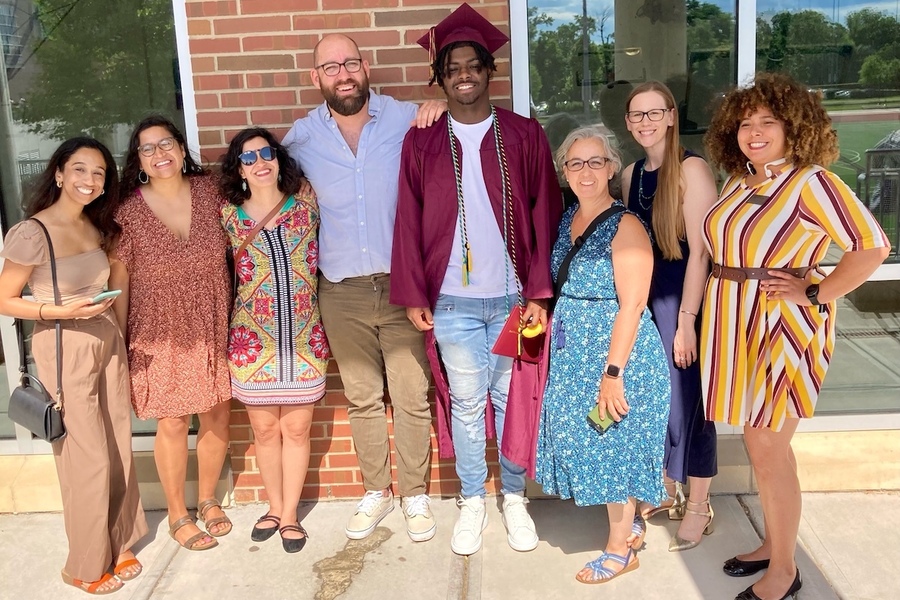High School Mentorship

Locations
- Thread, Maryland
Focus Area
- Education
"A healthy social fabric is made up of a diverse group of people who deeply understand themselves and one another. The relationships in Thread are transformational...for everyone involved."
The Issue
Every 26 seconds a student in the United States drops out of high school. That's 1.2 million kids each year.
Dropping out of high school is one of the most costly decisions a young person can make. Median earnings for high school graduates are $6,000 more than earnings for those who did not graduate. High school graduates also experience half the unemployment rate and improved health outcomes compared to dropouts. On the societal level, one paper found that the average high school dropout enacts lifetime costs of over $272,000 on the economy.
Baltimore neighborhoods suffer from high levels of both racial and socioeconomic segregation. In 2011-2012, 41.3% of high school students in Baltimore were chronically absent, which is defined as students who are enrolled in school for at least 90 days and miss at least 20 days. For the class of 2021, there was a 69% 4-year graduation rate in Baltimore City Public Schools, and 41% of the class of 2020 enrolled in college.
Thread in Baltimore harnesses the power of relationships to weave a new social fabric by connecting students for 10 years with an extended family of volunteers from the community.
The Intervention
Thread’s work focuses on youth who are in the lowest 25% of their class and are most likely to drop out of school. Each Thread student is matched with a group of up to four volunteers: an extended family that does whatever it takes to provide their student and family with completely customized support. This support can include packing lunches, providing rides to school, tutoring, connecting students and their families to existing community resources, and coordinating clothing, furniture, or appliance donations. These volunteers are able to build relationships and provide positive reinforcement and emotional support to underperforming students. Students remain enrolled in Thread through the remainder of high school and six years thereafter, for a total of ten years.
Thread’s mentoring model is unique because it emphasizes long-term relationship building; their goal is to provide a permanent social network to youth who are otherwise socioeconomically isolated. Their student outcomes suggest this model is working. Among Baltimore high school freshmen with a GPA below 1.0, the four-year high school graduation rate is less than 10 percent. In contrast, 57 percent of students from this population who participate in Thread graduate from high school within four years. Given this encouraging upper bound for the impact of Thread, LEO will carry out a randomized controlled trial (RCT) to identify the causal impact of Thread on graduation and other youth outcomes.
Research Question
What is the impact of community-based, long-term relationships across lines of difference for underperforming students on high school completion, post-secondary enrollment, employment and criminal involvement?
Intended Outcomes
Thread's goal is to:
- Increase high school attendance in year one
- Get students back on track to graduate by year two
- Students graduate high school by year three
Research Study Design
LEO seeks to evaluate Thread’s mentorship program through a retrospective study and a prospective RCT. There are more students eligible for Thread than there are available spots in the program, so Thread began using a lottery to select youth for the program over 10 years ago. Thread’s historical use of randomization will allow LEO to conduct a retrospective study on those who have been enrolled in previous Thread cohorts. In addition, LEO and Thread will continue to randomly assign youth to either the treatment or control group in the prospective study going forward.
Those in the treatment group will receive access to the Thread mentoring program. Over the course of 10 years, students will be supported by up to four community volunteers to guide and empower them to achieve their full potential inside and outside of the classroom. If the evidence shows that Thread’s community-based mentorship program is effective in improving outcomes, this will increase Thread’s ability to expand the program and ultimately serve more individuals.